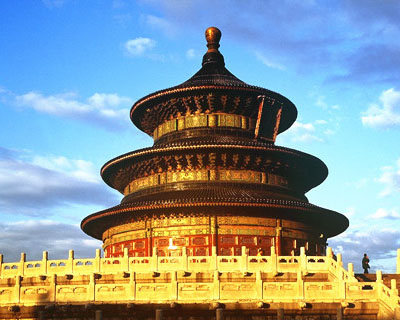
About 2km southeast of the Forbidden City towers Tian Tan, or the Temple of Heaven, where dynastic rulers in China used to worship the heaven. The temple plus subsidiary buildings and a surrounding garden covers an area five times the size of the Forbidden City. As Chinese emperors called themselves Tianzi, or the son of heaven, they had to cede supremacy to the heaven in terms of abiding.
2Chinese emperors had many other gods to worship apart from the god of heaven, including the gods of earth, water and war. They also worshipped their ancestors. As a result, religious activities were an important part of their busy work schedule. Temples of various kinds are scattered in Beijing. The best-known are the Temple of Heaven in the south, the Temple of Earth in the north, the Temple of Sun in the east, and the Temple of the Moon in the west. The Temple of Heaven is the grandest of them all.
The period of Qianlong’s reign is generally regarded as the most prosperous of the entire Qing Dynasty, and this prosperity was reflected in th lavish refurbishment of the hall. “After the restoration, the Hall of Prayer for Good Harvest glowed and shone with beautiful colors,” according to thTiantan Gongyuan Zhi (Records of the Temple of Heaven), compiled in 2002.
All this magnificence was destroyed by fire when the hall was struck by lightning in 1889, during the reign of Emperor Guangxu. The fire burned for a whole night, leaving only ashes of the building. The court was shocked by this ill omen, and Emperor Guangxu ordered the immediate rebuilding of the hall.
With no blueprint or other construction records to go by, the plan for the reconstruction relied on the memories of an old craftsman who had worked on an earlier restoration project of the hall, the Records of the Temple of Heaven says.
The China of the reign of Guangxu was considerably less affluent than it had been under Qianlong, but despite any budget restraints that may have been imposed, the reconstructed Hall of Prayer for Good Harvest was as exquisite as the original, although the artistic level of the painting of the building was not as high, antique expert Wang Shiren told Beijing Today.
3The Temple of Heaven was built in 1420 during the reign of Emperor Yongle of the Ming Dynasty. Situated in the southern part of the city, this grand set of structures covers an area of 273 hectares. To better symbolize heaven and earth, the northern part of the Temple is circular while the southern part is square. The whole compound is enclosed by two walls, a square wall outside a round one. The outer area is characterized by suburban scenery, while the inner part is used for sacrifices. The inner enclosure consists of the Hall of Prayer for Good Harvest and the Circular Mound Altar. Today the Hall of Prayer for Good Harvest is the hallmark of Beijing, which enjoys a prolonged history of civilization. The annex halls were symmetrically built on a 1.5-meter-high brick-and-marble terrace, to set off the loftiness and magnificence of the main hall. This unique building, 38 meters in height, is characterized by a cone-shaped structure with triple eaves and a top that is crowned by a gilt ball.
The roofing is made of blue glazed tiles, the color of the sky. Underneath the roof, the beams and brackets are decorated with colored paintings. The base of the structure is a triple-tiered, circular marble terrace. At a distance, the terrace looks like a gigantic, spiraling cloud with the structure perched on top of it. The Imperial Vault of Heaven is the main structure of Heaven's Storehouse. Aside from exquisitely laid out architectures, Heaven's Storehouse is also famous for two structures with peculiar acoustic features, i.e. the Echo Wall and the Triple-Sound Stone. A mere whisper at any point close to the wall can be heard clearly on the other side, although the parties may be 40 or 50 meters apart. This is possible because the wall is round and hermetically constructed with smooth, solid bricks. The Temple of Heaven is also famous for its cypress trees - there are more than 60, 000 cypress trees in all, among which over 4,000 are more than one hundred years old, adding to the solemn atmosphere of the temple.
 About 2km southeast of the Forbidden City towers Tian Tan, or the Temple of Heaven, where dynastic rulers in China used to worship the heaven. The temple plus subsidiary buildings and a surrounding garden covers an area five times the size of the Forbidden City. As Chinese emperors called themselves Tianzi, or the son of heaven, they had to cede supremacy to the heaven in terms of abiding.
About 2km southeast of the Forbidden City towers Tian Tan, or the Temple of Heaven, where dynastic rulers in China used to worship the heaven. The temple plus subsidiary buildings and a surrounding garden covers an area five times the size of the Forbidden City. As Chinese emperors called themselves Tianzi, or the son of heaven, they had to cede supremacy to the heaven in terms of abiding.